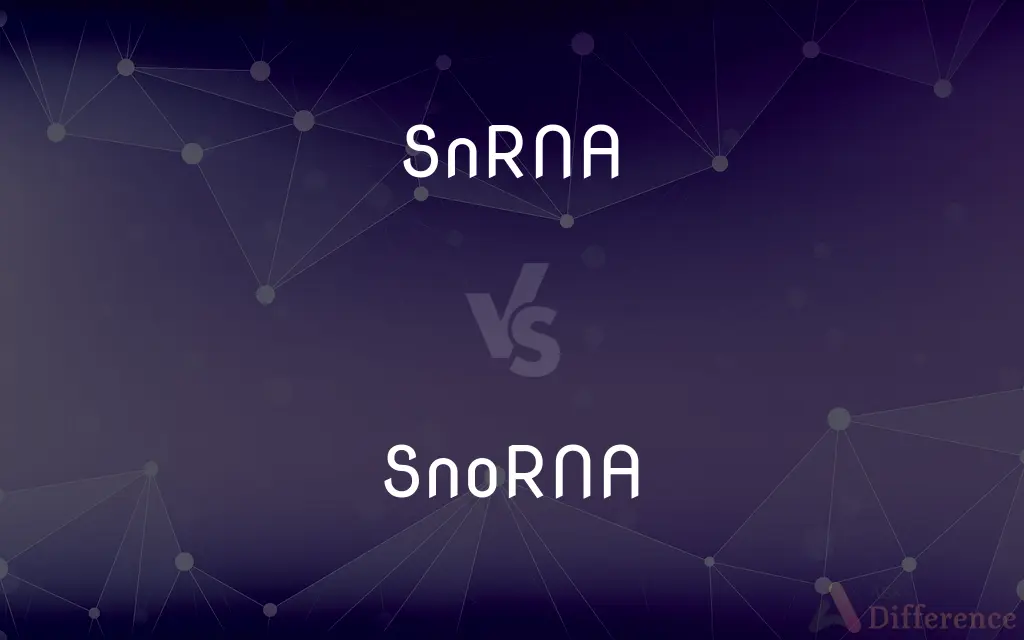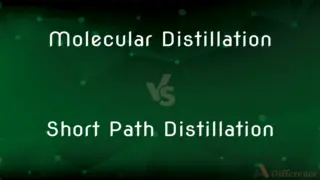SnRNA vs. SnoRNA — What's the Difference?
By Tayyaba Rehman — Published on November 3, 2023
SnRNA is involved in splicing, while SnoRNA guides chemical modifications of other RNAs. Both are distinct in function and RNA modification processes.

Difference Between SnRNA and SnoRNA
Table of Contents
ADVERTISEMENT
Key Differences
SnRNA, or Small Nuclear RNA, primarily functions within the nucleus and plays a crucial role in the process of splicing, which is the editing of pre-messenger RNA to transform it into mature messenger RNA. On the other hand, SnoRNA, or Small Nucleolar RNA, commonly serves to guide the chemical modifications of other RNAs, including ribosomal RNAs, transfer RNAs, and small nuclear RNAs, often through methylation and pseudouridylation processes.
In the intricate world of genetic machinery, SnRNA becomes a pivotal player in ensuring that the generated mRNA is accurate and ready for translation by eliminating introns. SnoRNA, conversely, generally focuses on modifying RNA molecules by guiding enzymes to specific modification sites, impacting the stability, function, and production of proteins by altering ribosomal RNA.
Despite their size and semblance, SnRNA and SnoRNA diverge significantly when it comes to their functional role in the cell. SnRNA combines with proteins to form small nuclear ribonucleoproteins (snRNPs) which are crucial components of the spliceosome. In contrast, SnoRNA often associates with proteins to form small nucleolar ribonucleoproteins (snoRNPs), which carry out the chemical modifications on the target RNAs.
In terms of cellular function, SnRNA, by participating in splicing, ensures that mRNA sequences are appropriately edited and matured to facilitate precise protein synthesis. Meanwhile, SnoRNA, with its modification capabilities, influences the function and efficiency of ribosomes and thereby, the synthesis of proteins, through its modifications on ribosomal RNA.
SnRNA and SnoRNA have been the subject of intense study, given their critical involvement in RNA processing and regulation. Despite being types of non-coding RNA, their intrinsic roles have profound implications for cellular functions, genetic regulation, and are even implicated in various diseases when their functions go awry.
ADVERTISEMENT
Comparison Chart
Primary Function
Splicing of pre-mRNA
Chemical modification of RNAs
Associated Ribonucleoproteins
Small nuclear ribonucleoproteins (snRNPs)
Small nucleolar ribonucleoproteins (snoRNPs)
RNA Interaction
Primarily with pre-mRNA
With rRNA, tRNA, and snRNA
Functional Locale
Nucleus
Nucleolus
Involvement in Diseases
Yes, e.g., Lupus
Yes, e.g., Prader-Willi Syndrome
Compare with Definitions
SnRNA
Small RNAs involved in mRNA splicing.
SnRNA works within the spliceosome to excise introns from pre-mRNA.
SnoRNA
Guides chemical modifications of RNAs.
SnoRNA directs the methylation of other RNA molecules.
SnRNA
Vital for accurate mRNA maturation.
The absence of functional SnRNA can hinder the formation of mature mRNA.
SnoRNA
Forms snoRNPs with associated proteins.
SnoRNA interacts with proteins, creating snoRNPs for RNA modification.
SnRNA
Implicated in certain autoimmune diseases.
Anomalies in SnRNA function have been associated with Lupus.
SnoRNA
Involved in ribosome function.
By modifying rRNA, SnoRNA indirectly influences ribosome activity.
SnRNA
Associate with proteins to form snRNPs.
SnRNA forms snRNPs, critical components in the splicing mechanism.
SnoRNA
Linked to genetic disorders.
Alterations in SnoRNA expression have been linked to Prader-Willi Syndrome.
SnRNA
Exists predominantly within the nucleus.
SnRNA functions within the nucleus to facilitate splicing processes.
SnoRNA
Mainly resides within the nucleolus.
The nucleolus is rich in SnoRNA due to its role in rRNA modification.
Common Curiosities
What does SnoRNA primarily modify?
SnoRNA mainly guides the chemical modification of rRNAs.
Do SnRNA and SnoRNA function in similar cellular locales?
No, SnRNA primarily functions in the nucleus, while SnoRNA is found in the nucleolus.
What is a notable role of SnoRNA?
SnoRNA plays a vital role in guiding RNA modification processes like methylation.
Is SnRNA involved in disease?
Yes, SnRNA abnormalities are associated with diseases like Lupus.
What is the main function of SnRNA?
SnRNA is crucial for the splicing of pre-mRNA.
What complex does SnRNA help form?
SnRNA helps form the spliceosome by creating snRNPs.
Can SnoRNA influence ribosome function?
Yes, through modifying rRNA, SnoRNA can affect ribosome activity.
Does SnRNA participate in RNA modification like SnoRNA?
No, SnRNA is primarily involved in RNA splicing, not modification.
Can SnoRNA impact the structure of tRNAs?
Yes, SnoRNA can guide modifications in tRNA molecules.
How does SnRNA impact protein synthesis?
SnRNA ensures accurate mRNA splicing, impacting subsequent protein synthesis.
Are SnRNA and SnoRNA considered coding RNAs?
No, both SnRNA and SnoRNA are types of non-coding RNAs.
Are SnoRNA and SnRNA found outside the nucleus?
Predominantly no, SnRNA and SnoRNA mainly function within the nucleus and nucleolus respectively.
How is SnoRNA linked to genetic disorders?
Dysfunctions in SnoRNA are associated with disorders like Prader-Willi Syndrome.
Is the malfunction of SnoRNA related to any cellular abnormalities?
Yes, aberrations in SnoRNA function can affect RNA modifications and subsequently, protein synthesis.
How does SnRNA influence genetic expression?
By mediating splicing, SnRNA influences the final mRNA and thus, protein expression.
Share Your Discovery

Previous Comparison
Molecular Distillation vs. Short Path Distillation
Next Comparison
Baby Pram vs. StrollerAuthor Spotlight
Written by
Tayyaba RehmanTayyaba Rehman is a distinguished writer, currently serving as a primary contributor to askdifference.com. As a researcher in semantics and etymology, Tayyaba's passion for the complexity of languages and their distinctions has found a perfect home on the platform. Tayyaba delves into the intricacies of language, distinguishing between commonly confused words and phrases, thereby providing clarity for readers worldwide.











































